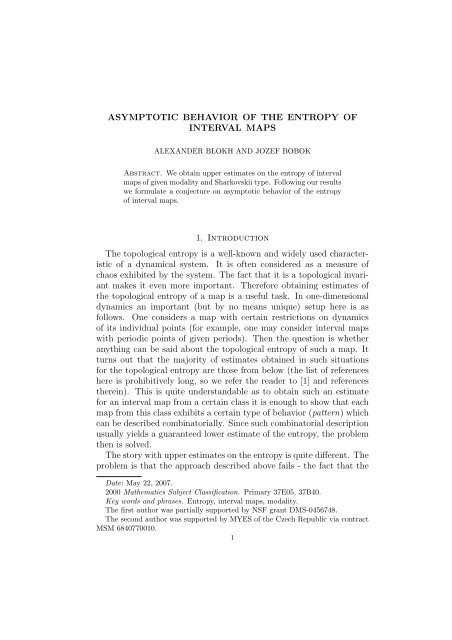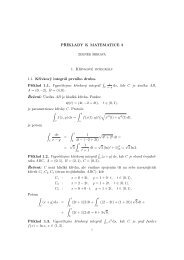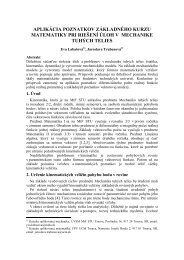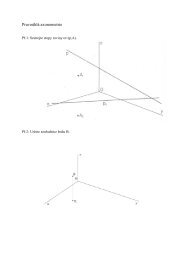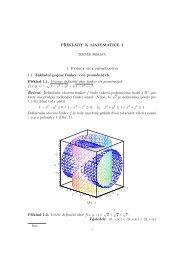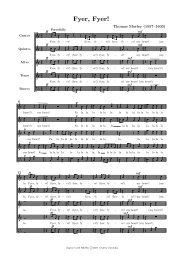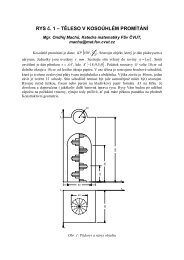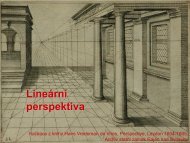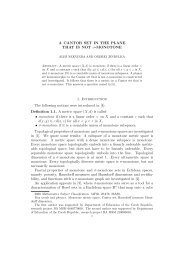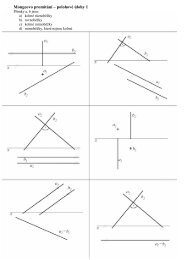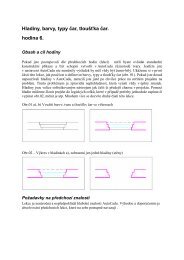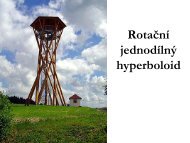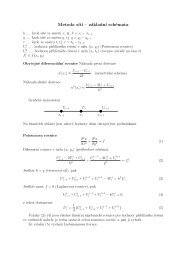ASYMPTOTIC BEHAVIOR OF THE ENTROPY OF INTERVAL MAPS ...
ASYMPTOTIC BEHAVIOR OF THE ENTROPY OF INTERVAL MAPS ...
ASYMPTOTIC BEHAVIOR OF THE ENTROPY OF INTERVAL MAPS ...
You also want an ePaper? Increase the reach of your titles
YUMPU automatically turns print PDFs into web optimized ePapers that Google loves.
<strong>ASYMPTOTIC</strong> <strong>BEHAVIOR</strong> <strong>OF</strong> <strong>THE</strong> <strong>ENTROPY</strong> <strong>OF</strong><strong>INTERVAL</strong> <strong>MAPS</strong>ALEXANDER BLOKH AND JOZEF BOBOKAbstract. We obtain upper estimates on the entropy of intervalmaps of given modality and Sharkovskii type. Following our resultswe formulate a conjecture on asymptotic behavior of the entropyof interval maps.1. IntroductionThe topological entropy is a well-known and widely used characteristicof a dynamical system. It is often considered as a measure ofchaos exhibited by the system. The fact that it is a topological invariantmakes it even more important. Therefore obtaining estimates ofthe topological entropy of a map is a useful task. In one-dimensionaldynamics an important (but by no means unique) setup here is asfollows. One considers a map with certain restrictions on dynamicsof its individual points (for example, one may consider interval mapswith periodic points of given periods). Then the question is whetheranything can be said about the topological entropy of such a map. Itturns out that the majority of estimates obtained in such situationsfor the topological entropy are those from below (the list of referenceshere is prohibitively long, so we refer the reader to [1] and referencestherein). This is quite understandable as to obtain such an estimatefor an interval map from a certain class it is enough to show that eachmap from this class exhibits a certain type of behavior (pattern) whichcan be described combinatorially. Since such combinatorial descriptionusually yields a guaranteed lower estimate of the entropy, the problemthen is solved.The story with upper estimates on the entropy is quite different. Theproblem is that the approach described above fails - the fact that theDate: May 22, 2007.2000 Mathematics Subject Classification. Primary 37E05, 37B40.Key words and phrases. Entropy, interval maps, modality.The first author was partially supported by NSF grant DMS-0456748.The second author was supported by MYES of the Czech Republic via contractMSM 6840770010.1
2 ALEXANDER BLOKH AND JOZEF BOBOKmap exhibits a certain type of behavior does not imply upper estimatesof the entropy.In fact, we know of only one paper where upper estimates of theentropy of a class of interval maps are done. In [4] (see also [3]) thesecond author investigated the topological entropy of green maps withprescribed (combinatorial) complexity - a characteristic not restrictingmodality but covering properties of laps of a piecewise-monotonemap. He proved that there is a close coherence between the best upperbounds of the entropy of such maps and bifurcation values of the parametersdetermining strictly monotone solutions to special differenceequations.In the majority of cases upper estimates of the entropy are not evenpossible because if the maps are not assumed polymodal, or if they arepolymodal but the modality is not bounded, then usually one can giveexamples of maps from a given class whose entropy is arbitrarily large.Therefore, a good approach to the problem of upper estimates of theentropy is to assume that maps which exhibit certain type of dynamicsare polymodal with bounded modality and use this modality as oneof the parameters involved in the estimates. This paper is devoted toobtaining upper estimates on the entropy of maps with two types ofrestrictions on the dynamics of their points; to describe the restrictionswe need to introduce a few known notions in one-dimensional dynamics.A useful characteristic of dynamics of interval maps is the so-calledSharkovskii type Sh(f) of the map f, that is the strongest - in thesense of the Sharkovskii ordering - period [10] of a periodic point of themap. The Sharkovskii ordering is the following ordering among naturalnumbers:3 ≺ 5 ≺ 7 ≺ · · · ≺ 2 · 3 ≺ 2 · 5 ≺ 2 · 7 ≺ · · · ≺ 8 ≺ 4 ≺ 2 ≺ 1In the case when n ≺ m we will say that n is stronger than m (in thesense of the Sharkovskii ordering). Denote by P (f) the set of periodsof cycles of an interval map f. Also, denote by S(k) the set of all suchintegers m that k ≺ m or k = m and by S(2 ∞ ) the set {1, 2, 4, 8, . . . }.The importance of the Sharkovskii ordering is explained by the famousSharkovskii Theorem on co-existence of periods of cycles of intervalmaps, a major result in one-dimensional dynamics stated below.Theorem 1.1. Let g : [0, 1] → [0, 1] be a continuous map. Then thereexists such k ∈ N ∪ 2 ∞ that P (g) = S(k). Moreover for any such kthere exists a map g : [0, 1] → [0, 1] with P (g) = S(k).In the original proof of the Sharkovskii Theorem [10] another factabout interval maps is used as a technical tool. Following Sharkovskii,
<strong>ASYMPTOTIC</strong> <strong>BEHAVIOR</strong> <strong>OF</strong> <strong>THE</strong> <strong>ENTROPY</strong> <strong>OF</strong> <strong>INTERVAL</strong> <strong>MAPS</strong> 3we say that an interval map f has an L-scheme if there exists a fixedpoint a and a point b such that either f 2 (b) ≤ a < b < f(b), or f 2 (b) ≥a > b > f(b) (because of the symmetry of the notion we will assumebelow that if f has an L-scheme then in fact f 2 (b) ≤ a < b < f(b)). Inthis case we will also say that the points a, b form an L-scheme. Oneof the results of [10] is that a map which has an L-scheme has periodicpoints of all periods.Observe, that if f has an L-scheme then the intervals I = [a, b], J =[b, f(b)] have disjoint interiors and are such that their images covertheir union. In other words, they form the so-called 2-horseshoe (theimportance of horseshoes for interval maps became clear after papers[6, 7, 8, 9], see also [1] and references therein), and in fact it is easy tosee that if a map has a 2-horseshoe then it must have an L-scheme.Our aim is to estimate the entropy of an interval map from aboveassuming that it does not have any L-scheme and that its modality(see below) is known. We need some definitions. A continuous mapis said to be monotone if pointwise preimages are connected (this isactually a general definition which applies to maps of any topologicalspaces). Thus, in the interval case we understand monotonicity in thenon-strict sense. An interval map f : I → I is said to be piecewisemonotoneif there are finitely many points dividing I into subintervalson each of which f is monotone. The least number q of such (inner)points is called the modality of f and denoted by mod(f), the map fthen is said to be q-modal, and q + 1 closed intervals into which I getspartitioned are then called laps of f.Theorem 1.2. Let f be a q-modal map without L-scheme (e.g., this istrue if Sh(f) ≠ 3). Then h(f) ≤ ln( √ .75q 2 + 1.5q + 1.25 + .5)Denote the supremum of the entropy of a map f with Sh(f) = sand modality q by h(s, q). Concerning the numbers h(s, q) one canask various questions on their (asymptotic) behavior with respect toSharkovskii type and modality. The simplest observation can be donewith the help of Figure 1. Using a suitable extension of a unimodal mapof type s one can construct a map of type s and modality q. It impliesthat the number h(s, q) exists for any pair s, q. Similar argument showsthat the sequence {h(s, q)} q is non-decreasing for any type s. On theother hand, proofs of some properties require more subtle technics anddetailed analysis (for instance, the fact that h(s, q) need not be a maximum(as it is for s = 3), answering the question if h(s, q) < h(s, q + 1)for each modality q, resp. h(s, q) > h(s ′ , q) whenever s ≺ s ′ and sis not a power of two). In this paper we prefer rather (new) differentapproach - to get some information on the asymptotic behavior of
4 ALEXANDER BLOKH AND JOZEF BOBOKh(s, q) with fixed s as q → ∞. In this direction Theorem 1.2 enablesus to estimate the asymptotical difference lim inf q→∞ h(3, q) − h(5, q).Indeed, by the result of Misiurewicz and Szlenk [9], h(3, q) = ln(q + 1)and from Theorem 1.2 we getln( √ .75q 2 + 1.5q + 1.25 + .5) ≥ h(5, q)for each q hence we see that lim inf q→∞ h(3, q) − h(5, q) > 0 - see thelast theorem of this section. This can be interpreted as an indication ofthe fact that the dynamical restriction upon a map which is introducedas we fix its Sharkovskii type is significant - after all, it can be detectedthrough the entropy as we let the modality to tend to infinity.0 ab 1Figure 1. For 0 < a < b < 1 and q ′ > q, any q-modal mapf : [a, b] → [a, b] of type s can be extended to a q ′ -modal map˜f : [0, 1] → [0, 1] of the same Sharkovskii type and the entropy.We conjecture that in fact the same should hold for all other fixedSharkovskii types of interval maps except for the case when both typesare powers of 2 (including 2 ∞ , and hence the entropy is zero, see [6,7, 8, 9]). More precisely, we would like to formulate here the followingconjecture.Conjecture 1.3. Given two Sharkovskii types s ′ ≺ s ′′ which are notboth equal to powers of 2 we have that lim inf q→∞ h(s ′ , q)−h(s ′′ , q) > 0.In fact, in a simple case when s ′ = 3 · 2 k ≺ s ′′ = 3 · 2 l have differentpowers of 2 involved in their prime decompositions, Conjecture 1.3follows easily from the lemma below which can be obtained using thesame tools as the ones used in the proof of Theorem 1.2.
<strong>ASYMPTOTIC</strong> <strong>BEHAVIOR</strong> <strong>OF</strong> <strong>THE</strong> <strong>ENTROPY</strong> <strong>OF</strong> <strong>INTERVAL</strong> <strong>MAPS</strong> 5Lemma 1.4. Let f be a q-modal map with Sh(f) = (2s + 1)2 k , s ≥ 0,k ≥ 0. Then h(f) ≤ ln(1 + 2 −k q).We finish this section by theorem that summarizes the cases whenwe are able to estimate the asymptotical differences of entropies fromour conjecture.Theorem 1.5. Let the numbers h(s, q) be as above. Then(1) lim inf q→∞ h(3, q) − h(5, q) ≥ ln(2/ √ 3).(2) If 0 ≤ k ≤ l then lim inf q→∞ h(3 · 2 k , q) − h(3 · 2 l , q) ≥ ln 2 l−k .In conclusion we want to say, that even though in general the verificationof Conjecture 1.3 may require a set of tools finer than the onesemployed in the present paper, we hope that developing our tools willbe helpful in fulfilling this task.2. PreliminariesFirst of all, we would like to make some simplifications concerningthe notion of L-scheme. Suppose that points x, y form an L-schemeand f 2 (y) ≤ x = f(x) < y < f(y). Choose the closest to y from theleft fixed point x ′ . Since f 2 (y) < y < f(y) then there is a fixed pointbetween y and f(y); let u be the closest from the right to y fixed point.Then f 2 (y) ≤ x ≤ x ′ < y < u < f(y) and f(z) > z for all z ∈ (x ′ , u).Choose a preimage q of x ′ among points of the interval [u, f(y)], thenchoose a preimage p of q among points of [x ′ , u]. We conclude thatf 2 (p) = x ′ = f(x ′ ) < p < f(p) and f(z) > z for any z ∈ (x ′ , p). Fromnow on when saying that points p, q form an L-scheme we will meanonly this behavior - or its exact symmetric copy. Also, it is clear that toestimate the topological entropy from above it is sufficient to consideronly interval maps with positive entropy.We need a result of [2]; to state it we need to introduce a few notions.An interval I is said to be periodic (of period n) if I, f(I), . . . , f n−1 (I)are pairwise disjoint while f n (I) = I. Set orb(I) = ∪ n−1j=0 f j (I). A maprestricted on the orbit of a periodic interval (of period n) is said to benon-strictly periodic (of period n); such a map is said to be transitiveif there exists a point x whose orbit is dense. Finally, according to howwe define monotonicity, a map from a union of disjoint closed intervalsonto a union of disjoint closed intervals is monotone if and only if foreach point in the range its preimage is a closed interval.Theorem 2.1. [2] Suppose that f is a piecewise-monotone interval mapof positive entropy. Then there exists a periodic interval I of period nsuch that the following holds:
6 ALEXANDER BLOKH AND JOZEF BOBOK(1) f| orb(I) is semiconjugate by a monotone map ϕ to a transitivenon-strictly periodic map g of period n;(2) h(f) = h(f| orb(I) ) = h(g).Observe that since the semiconjugacy above is monotone, preimagesof points are closed intervals and so if g has a point of some period thenso does f. In what follows given a piecewise-monotone interval map fof positive entropy we fix some choice of the objects whose existenceis proven in Theorem 2.1 and denote them as follows: the periodicinterval I is denoted by I f , the semiconjugacy ϕ is denoted by ϕ f , theperiod of I is denoted by n f , the transitive non-strictly periodic map gis denoted g f and the periodic interval on the orbit of which the mapg f is defined is denoted M f (we assume that ϕ f (I f ) = M f ).We will also need another result which deals with transitive intervalmaps. To do so we need another definition: a non-strictly periodic mapis said to be (topologically) mixing if for any open U, V there existsn ≥ 0 such that for any i ≥ n the sets f i (U) and V are non-disjoint.Lemma 2.2. [2] Suppose that f : [0, 1] → [0, 1] is a transitive intervalmap. Then exactly one of the two cases holds:(1) the map f is mixing and Sh(f) = 2n + 1, n ≥ 1;(2) there exists a point a ∈ (0, 1) such that f[0, a] = [a, 1], f[a, 1] =[0, a], restrictions f 2 | [0,a] , f 2 | [a,1] are mixing, and Sh(f) = 6.Upper estimates of the entropy of interval maps are often times basedupon the following proposition whose proof we only sketch. We needyet a few definitions. Given a piecewise-monotone q-modal map f withlaps K 0 , . . . , K q define the dynamic matrix Dyn f = (a ij ) of f by thefollowing rule: a ij = 1 if f(K i ) ∩ K J ≠ ∅ and a ij = 0 if f(K i ) ∩ K j =∅. Also, consider the dynamic oriented graph G f of f with verticesK 0 , . . . , K q which corresponds to Dyn f and is defined as follows: anoriented edge (an arrow) in G f from K i to K j exists if and only iff(K i ) ∩ K j ≠ ∅. Denote by r(A) the spectral radius of a matrix A.Proposition 2.3. Suppose that f : [0, 1] → [0, 1] is piecewise-monotonemap. Then h(f) ≤ r(Dyn f ).Proof. By the results of Misiurewicz and Szlenk [9] (see also [6, 7, 8]),the entropy of f can be computed as follows. Consider the modalitymod(f n ) of f n ; then the limit of the sequence n −1 ln(mod(f n ) + 1)exists and equals the topological entropy h(f) of f. In other words,the entropy is defined by the asymptotic behavior of the number oflaps of f n as n tends to infinity. Consider the graph G f . Clearly thenumber of laps of f n is no more than the number of oriented paths of
<strong>ASYMPTOTIC</strong> <strong>BEHAVIOR</strong> <strong>OF</strong> <strong>THE</strong> <strong>ENTROPY</strong> <strong>OF</strong> <strong>INTERVAL</strong> <strong>MAPS</strong> 7length n − 1 in G f (i.e., paths consisting of n − 1 consecutive arrows).On the other hand, according to our definition of the dynamic matrixDyn f of f, the number of all such paths equals the sum of all entries in. By the well-known properties of the spectral radius of matricesit follows that the entropy of f is no more than the spectral radius ofDyn f as desired.□Dyn n−1fWe also need estimates on eigenvalues of matrices. Given an n × nmatrix A, denote by a ij its entries and by r(A) its spectral radius.Also, given i denote by m i the maximum of the absolute value of anon-diagonal element of the i-th row in A (by the diagonal of a matrixwe always mean its main diagonal). With this notation, setb(A) =n∑i=1(m −1i ·The following lemma is proven in [5].n∑j=1,j≠i|a ij |).Lemma 2.4. Let A be an n × n matrix. Choose a number α > 0 suchthat α(α + 1) ≥ b(A). Then all eigenvalues of A belong to the union ofdisks |a ii − z| ≤ αm i .Corollary 2.5. Let A be a matrix whose entries are equal to either0 or 1, in each row there is at least one non-zero non-diagonal entry,and there are R non-zero entries outside the diagonal. Then r(A) ≤√R + .25 + .5.Proof. In the situation of the corollary, m i = 1, 1 ≤ i ≤ n. Henceb(A) = R. The minimal α satisfying the inequality α(1 + α) ≥ R isgiven by ˆα = √ R + .25 − .5. Since |a ii | ≤ 1, 1 ≤ i ≤ n, we see that byLemma 2.4 r(A) ≤ √ R + .25 + .5 as desired.□3. Main TheoremIn order to prove our main theorem as well as Lemma 1.4 we needthree more lemmas.Lemma 3.1. Let f : [0, 1] → [0, 1] be a transitive map without L-scheme. Then f has a unique fixed point a ∈ (0, 1) such that f(x) > xfor any x < a, and f(x) < x for any x > a.Proof. Let us show that f cannot have two fixed points. Indeed, supposeotherwise. Then we may assume that a and b are fixed pointsand f(x) > x for any x ∈ (a, b). Then by transitivity b < 1. Let usshow that a ∈ f([b, 1]). Indeed, otherwise [b, 1] ∪ f([b, 1]) is an invariantsubinterval of [0, 1] not containing a which contradicts transitivity.
8 ALEXANDER BLOKH AND JOZEF BOBOKNow, take the smallest c ∈ [b, 1] with f(c) = a. Then there existsd ∈ (a, c) such that f(d) = c because otherwise [a, c] is invariant whichby transitivity implies a = 0, c = 1 and by surjectivity for some d wemust have f(d) = c with d ≠ c because f(c) ≠ c. We conclude thata = f(a) = f 2 (d) < d < f(d) = c which means that f has an L-scheme,a contradiction.□Before we state the next lemma observe that the notion of modalitycan be introduced for non-strictly periodic map similarly as it isdone for an interval map (the least number of points dividing its domaininto subintervals on each of which a map is monotone). Say thata closed interval J is weakly periodic ( for f of period l) if int(J),int(f(J)), . . . , int(f l−1 (J)) are pairwise disjoint while f l (J) = J. Observethat in the case of a weakly periodic interval J the union of alliterates of J (the orbit orb(J)) is a finite forward invariant union ofclosed intervals.Lemma 3.2. Let f be a non-strictly periodic map of modality q andJ be a closed interval weakly periodic of period l. Then h(f| orb(J) ) ≤ln(1 + q/l).Proof. By the quoted above result of Misiurewicz and Szlenk we canestimate the entropy of f| orb(J) for J from above as follows. Let n i bethe modality of f| f i (J). Then by [6, 7, 8, 9] we have thath(f| orb(J) ) ≤ l −1 ln[Π l−1i=0 (n i + 1)].Since f has modality q then ∑ l−1i=0 (n i + 1) ≤ l + q. Together with theabove inequality this implies thath(f| orb(J) ) ≤ l −1 ln[( l + q ) l ] = ln(1 + q/l).lThe following lemma combines and specifies results of Theorem 2.1and Lemma 2.2.Lemma 3.3. Let f be a piecewise-monotone interval map of Sharkovskiitype Sh(f) = (2s + 1)2 k , s ≥ 1. Then there exists a number l ≥ 2 k ,a closed interval J ⊂ I f and a subinterval K ⊂ M f weakly periodicfor g f of period l such that h(f l | J ) = h(f l ), f l | J is monotonically semiconjugateto a mixing interval map H = gf l | K of the same entropy.Moreover, one of the following holds:(1) l = n f , J = I f , and f has a point of period (2r + 1)l, r ≥ 1;(2) l = 2n f , H has an L-scheme, and f has a point of period 3l.□
<strong>ASYMPTOTIC</strong> <strong>BEHAVIOR</strong> <strong>OF</strong> <strong>THE</strong> <strong>ENTROPY</strong> <strong>OF</strong> <strong>INTERVAL</strong> <strong>MAPS</strong> 9Proof. Consider the two cases corresponding to the cases from Lemma 2.2.Set G = g n ff| M f; by Theorem 2.1 G is transitive.(1) Suppose that G is mixing. Set H = G, J = I f , K = M f andl = n f . Since the semiconjugacy is monotone, preimages of points areclosed intervals and so if H has a point of some period then so doesf n f = f l . By Lemma 2.2 H has a point of an odd period 2r + 1, r ≥ 1.Since J = I f is an f-periodic interval and all its iterates until f l (J) = Jare pairwise disjoint then f has a point of period (2r +1)l, r ≥ 1. Sincel < 2 k implies (2r + 1)l ≺ (2s + 1)2 k = Sh(f), we obtain l ≥ 2 k asdesired.(2) Suppose that G is not mixing. We may assume that M f = [0, 1].Then there exists a point a ∈ (0, 1) such that G[0, a] = [a, 1], G[a, 1] =[0, a] and both restrictions G 2 | [0,a] , G 2 | [a,1] are mixing. Set H = G 2 | [0,a] .Since a is a fixed endpoint of H, Lemma 3.1 implies that H has an L-scheme, hence also a point of period 3. Set J = ϕ −1f([0, a]), K = [0, a]and l = 2n f . It follows that f l | J is monotonically semiconjugate byϕ f to a mixing map H. The interval J maps back into itself by f l ,still it is not f-periodic of period l because f l/2 (J) intersects J overa subset of the interval R = ϕ −1f(a). However all other iterates of Juntil f l (J) = J are disjoint from J. Clearly, f has a point of period3l. Since l < 2 k implies 3l ≺ (2s + 1)2 k = Sh(f), we obtain l ≥ 2 k asdesired.□In what follows, J, l, K, g f and H are as in Lemma 3.3. It is easyto see that Lemma 3.3, Lemma 3.2 and Lemma 2.2 imply Lemma 1.4.Proof of Lemma 1.4. The conclusion holds when s = 0, since thenh(f) = 0 [1]. For s ≥ 1, we want to apply Lemma 3.2 to g f . Themodality of g f is at most q. On the other hand, ϕ f (orb(I f )) = orb(K),and K is a weakly periodic interval for g f of period l ≥ 2 k . Hence byLemma 3.2 h(f) = h(g f | orb(K) ) ≤ ln(1 + q/l) ≤ ln(1 + 2 −k q) as desired.□We are ready now to prove Theorem 1.2.Proof of Theorem 1.2. Set K = [0, 1]. By Lemma 1.4 and Lemma3.3 h(f) ≤ ln(1 + q/l). If l > 1 then h(f) ≤ ln(1 + q/l) ≤ ln(1 + q/2)
10 ALEXANDER BLOKH AND JOZEF BOBOKH 2 (y) = x = H(x) < y < H(y) and H(z) > z for any z ∈ (x, y).The ϕ f -preimage of x is an interval [a, b], and the ϕ f -preimage of y isan interval [c, d]. Since H(z) > z for any z ∈ (x, y) then because ofmonotonicity of ϕ f we see that f(z ′ ) > z ′ for z ′ ∈ (b, c). By continuitythen f(b) ≥ b. Since f([a, b]) ⊂ [a, b] we conclude that f(b) = b. Itfollows that b, c form an L-scheme of f, a contradiction. Also, it isclear that the modality of H is at most q. Let us now use these factsto estimate h(H).Let J 1 < J 2 < · · · < J r , r ≤ q + 1 be laps of H. Consider thematrix A H = Dyn H . By Proposition 2.3 h(H) ≤ ln r(A H ). Let us nowestimate r(A H ). By Lemma 3.1 we may assume that d is a unique fixedpoint of H; observe also that H has no flat spots since it is mixing.Then d cannot be a turning point of H. Indeed, otherwise pointsin a small semi-neighborhood of d stay on the same side of d whilebeing mapped towards d, a contradiction with mixing of H. Hence wemay assume that in a small neighborhood of d the map H is strictlydecreasing. Let J s be the interval containing d. If i < s then H(J i ) isdisjoint from J t for each t < i, and if i > s then H(J i ) is disjoint fromJ t , t > i.Let us construct a matrix B as follows.(1) If i < s, set b it = 0 for t < i and b it = 1 for t ≥ i.(2) If i = s, set b it = 1 for every t.(3) If i > s, set b it = 1 for t ≤ i and b it = 0 for t > i.Observe, that for every pair i, t we have a H it ≤ b it . Hence r(A H ) ≤r(B). Let us estimate r(B) from above using Corollary 2.5 whichobviously applies to B. To this end let us estimate the number Rof non-diagonal non-zero entries in the matrix B. It follows from theconstruction of B that∑s−1r∑R = ( r − i) + r + ( i − 1) = .5[−2s 2 + 2(r + 1)s + r 2 − r].i=1i=s+1It is easy to check, that the maximal value of R is .75r 2 + .25 andthat it is reached if s = (r + 1)/2. Since r ≤ q + 1 we conclude thatR ≤ .75q 2 + 1.5q + 1. By Corollary 2.5 and since r(A H ) ≤ r(B) thisimplies thatHencer(A H ) ≤ r(B) ≤ √ R + .25 + .5 ≤ √ .75q 2 + 1.5q + 1.25 + .5as desired.h(f) = h(H) ≤ ln( √ .75q 2 + 1.5q + 1.25 + .5)□
<strong>ASYMPTOTIC</strong> <strong>BEHAVIOR</strong> <strong>OF</strong> <strong>THE</strong> <strong>ENTROPY</strong> <strong>OF</strong> <strong>INTERVAL</strong> <strong>MAPS</strong> 11Proof of Theorem 1.5. (1) Since h(3, q) = ln(q + 1) and by Theorem1.2, h(5, q) ≤ ln( √ .75q 2 + 1.5q + 1.25 + .5), we get easilylim infq→∞h(3, q) − h(5, q) ≥ lim ln q + 1√q→∞ .75q2 + 1.5q + 1.25 + .5 = ln √ 2 . 3(2) For ν ∈ N ∪ {0}, let π = (1 π(1) . . . π 2ν −1 (1)) be a cyclic permutationsuch that ’connect-the-dots’ map f π has zero topological entropyand for ν ≥ 2 is unimodal [1]. Consider intervals [a 1 , b 1 ] < · · ·
12 ALEXANDER BLOKH AND JOZEF BOBOKonly periodic points outside M are of periods which are powers of 2, acontradiction.Moreover, using (1)-(4) we gethence by Lemma 1.4,mod(g ν,r ) = (2 ν − 1)2r + (2r − 1) = 2 ν+1 r − 1,h(g ν,r ) ≤ ln(1 + 2 −ν (2 ν+1 r − 1)) = ln(2r + 1 − 2 −ν ) = V 1 (ν, r).On the other hand by (1)-(4), each lap of g 2ν | [aj ,b j ] maps by g 2ν onto[a j , b j ]. Since h(g) = h(g| orb([aj ,b j ])) = 1 h(g 2ν |2 ν [aj ,b j ]), we get from [9]h(g ν,r ) = 1 2 ν ln((2r + 1)2ν −1 2r) = ln(2r + 1) + 1 2 ν lnBy our definition, h(s, 1) ≤ h(s, 2) ≤ · · · ; since2r2r + 1 = V 2(ν, r).mod(g ν,[q+1]) ≤ q ≤ mod(g2 ν+1 ν,1+[ q+12ν+1 ])and for each 0 ≤ k ≤ lV 2 (k, [ q + 12 ]) ≤ h(3 · k+1 2k , q), h(3 · 2 l , q) ≤ V 1 (l, 1 + [ q + 1 ])2l+1 we can write for each q,V 2 (k, [ q + 12 ]) − V 1(l, 1 + [ q + 1k+1 2 ]) ≤ h(3 · l+1 2k , q) − h(3 · 2 l , q).Since lim q→∞ V 2 (k, [ q+12 k+1 ]) − V 1 (l, 1 + [ q+12 l+1 ]) = ln 2 l−k , we have alsoas desired.lim infq→∞h(3 · 2k , q) − h(3 · 2 l , q) ≥ ln 2 l−kReferences[1] L. Alseda, J. LLibre, M. Misiurewicz, Combinatorial Dynamics and Entropyin Dimension One, World Scientific, Singapore (Advanced Series inNonlinear Dynamics, 5), Second Edition (2000)[2] A. Blokh, The Spectral Decomposition for One-Dimensional Maps, DynamicsReported, 4 (1995), 1–59.[3] J. Bobok, On entropy of patterns given by interval maps, Fund. Math.,162 (1999), 1–36.[4] J. Bobok, On the topological entropy of green interval maps, J. App. Anal.,7 (2001), 107–112.[5] Fan Ky, A. J. Hoffman, Lower bounds for the rank and location of theeigenvalues of a matrix, Nat. Bureau Stand., Appl. Math. Ser., 39 (1954),117–130.[6] M. Misiurewicz, Horseshoes for mappings of the interval, Bull. Acad. Pol.Sci., Ser. sci. math., astr. et phys. 27 (1979), 167–169.□
<strong>ASYMPTOTIC</strong> <strong>BEHAVIOR</strong> <strong>OF</strong> <strong>THE</strong> <strong>ENTROPY</strong> <strong>OF</strong> <strong>INTERVAL</strong> <strong>MAPS</strong> 13[7] M. Misiurewicz, Horseshoes for continuous mappings of an interval, in:Dynamical Systems, Liguori Editore, Napoli (1980), 127–135.[8] M. Misiurewicz, W. Szlenk, Entropy of piecewise monotone mappings, Asterisque50 (1977), 299–310.[9] M. Misiurewicz, W. Szlenk, Entropy of piecewise monotone mappings, StudiaMath. 67 (1980), 45–63.[10] A. N. Sharkovskii, Coexistence of the cycles of a continuous mapping ofthe line into itself, Ukrain. Math. Jour. 16 (1964), 61–71.(Alexander Blokh) Department of Mathematics, University of Alabamaat Birmingham, Birmingham, AL 35294-1170(Jozef Bobok) KM FSv. CVUT, Thakurova 7, 166 29 Praha 6, CzechRepublicE-mail address, Alexander Blokh: ablokh@math.uab.eduE-mail address, Jozef Bobok: bobok@mat.fsv.cvut.cz


